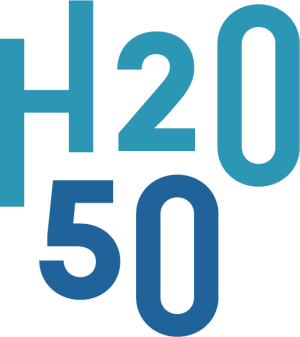Did you know? The speed of water in drinking water pipes and in Flemish watercourses is approximately several dm/sec. Groundwater flows much slower, with speeds of around several cm/day.
Transport and mobility are central issues in various sustainability challenges. The idea that a sustainable world is one in which light things are exchanged globally (e.g. information), and heavy things remain mainly local and organised in cycles as much as possible, is anything but elaborated as a vision, but it is expressive and powerful in its simplicity. This means that any source that is essentially always nearby, such as water, will also be transported as little as possible, because transport requires more infrastructure, energy, space, as the distance increases.
Water is not as fast and flashy to move as electricity, information or gas. Transport over long distances is also vulnerable. As such, it is better to focus on the availability of “nearby water”. Guaranteeing this availability means retaining water locally, moving as little water as possible to other regions unnecessarily, and being as independent as much as possible from other regions. Independence therefore also means that a business park, district, or individual building draws as little water as possible from its surroundings and discharges as little waste water into it as possible.
Both extraction and discharge are important in this regard. The impact of importing and diverting water must be taken into account. Today, for example, rainwater is increasingly used to flush toilets; this avoids the need to supply treated water from somewhere else. It is commendable that rainwater and not tap water is used, but after, the rinse water typically ends up in the sewer, and that is how the rainwater is transported over a longer distance, treated and generally discharged into a canal.
It would be better if the rainwater, once used, is treated locally and infiltrated into the soil. Of course, this means that it is not enough to tap alternative local water sources, but that treating water to a standard that allows for infiltration and buffering in the surrounding area is also necessary. There are many advantages to this, such as less need for transporting mains water, less need for sewers, better water buffering through gradual infiltration. The technology to set something up like this already exists, and can be applied at building or neighbourhood level.
To facilitate it, the policy instrument of the Water Kilometre can be used. Where the water kilometre is the volume of water that has to be supplied or diverted over a given distance (km) over a period of 1 year. A price can then be associated with this water kilometre. This encourages companies to set up where water is available, or where better water treatment technologies have been installed. A (drinking) water company or private actor can proactively take on a role by purifying waste water into drinking water in order to reduce the water kilometre for the city as a whole.
We would like to calculate this policy instrument further and come up with an answer to the following questions: (1) How is the price set?; (2) How do we bridge the period in which the poorest will have to pay the additional cost? How do we ensure that we do not end up in a situation where social compensations cancel out profits, and (3) What is the added value of the water kilometre in reducing peak consumption?
Download all catalysts
Disclaimer
The Flemish Environment Agency (VMM), De Vlaamse Waterweg, De Watergroep, Aquafin, the Flemish Department of Environment, Farys, Pidpa, water-link and VITO - Vlakwa have created the space for a group of fresh thinkers to develop a systemic view of water, and to challenge the water sector to shape a futureproof water system. The formulated ideas are not those of the initiators, nor do they represent their stands. However, they are considered valuable as an inspiration for the future of our water system.
This work is licensed under a Creative Commons Attribution 4.0 International License.
